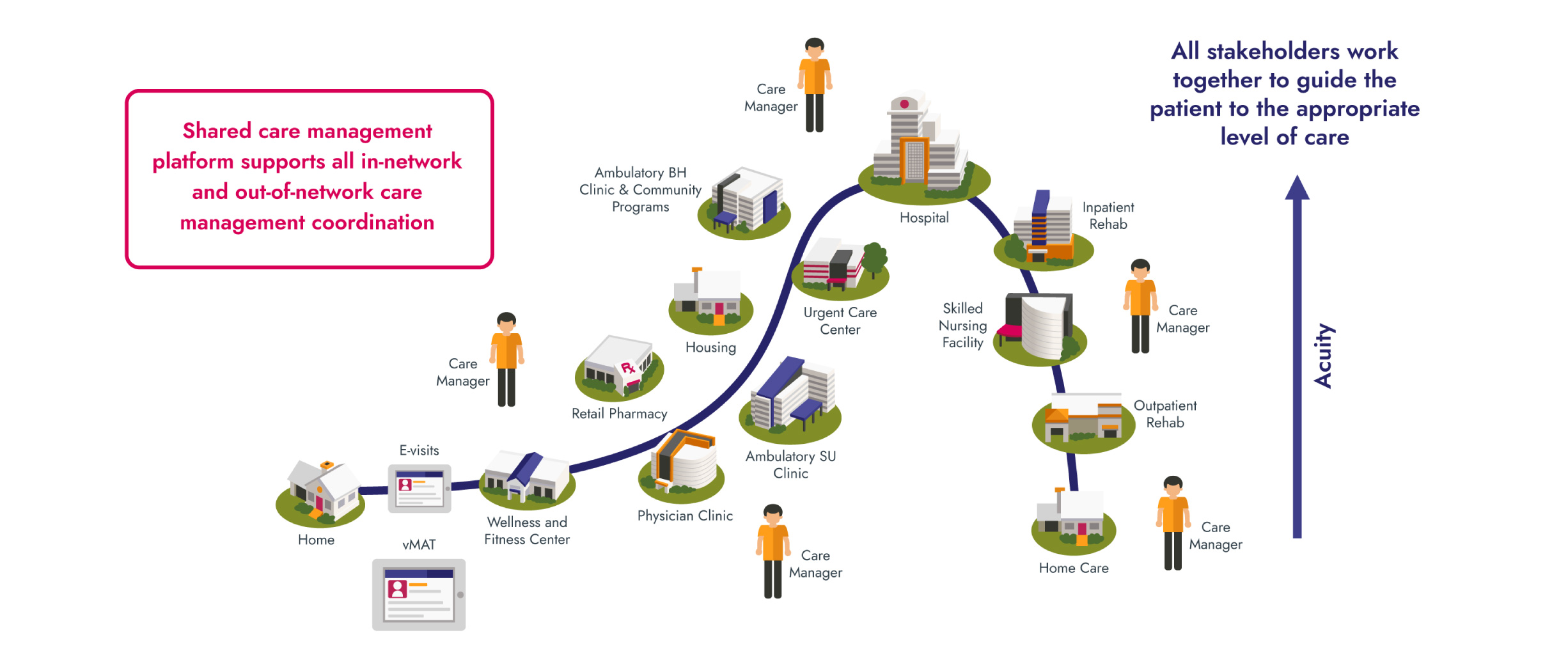If you or someone you know is in crisis, please call the National Suicide Prevention Lifeline at 988 or contact the Crisis Text Line by texting HOME to 741741
A Primer on Achieving 988 Crisis Call Center Success
Take a deep dive into what 988 crisis call centers must do to meet requirements and expectations.
Read the guide below or enter your email to download your copy to take on the go.

Introduction
Since the country's three-digit crisis phone number, 988, became available in July 2022, the more than 200 state and local call centers comprising the 988 Suicide & Crisis Lifeline network have made a difference in the lives of millions of people. A KFF analysis of Lifeline data found that in its first year, 988 received almost 5 million contacts. Of this, 1 million were from the Veteran's Crisis Line — part of 988 — with the rest consisting of 2.6 million calls, more than 740,000 chats, and more than 600,000 texts.
But the responsibility of 988 crisis call centers — and organizations providing select crisis management services — goes well beyond receiving contacts. A comprehensive and integrated crisis network is the first line of defense in preventing tragedies of public and patient safety, civil rights violations, extraordinary and unacceptable loss of lives, and wasted resources.
In this Primer, developed by the 988 experts at Core Solutions, we'll examine the importance and components of the system of care approach required to help ensure those experiencing a crisis quickly receive the appropriate level of care and real-time care coordination. We'll review guidelines and then examine some essential best practices to deliver high-performing regional crisis call services. We'll then dive into the technology needed to effectively power these services and share other features and qualities a 988 crisis call center should look for in a crisis care management system and solution provider.
When you finish this Primer, you will come away with a better understanding of what's needed for your 988 operator to meet requirements and expectations. More importantly, you should be empowered to achieve a more effective and efficient coordinated response that improves and saves lives.
System of Care Approach

Effective crisis care that saves lives and dollars requires a systemic — i.e., system of care — approach. The concept of a system of care is not new. Back in 2000s, before the Health Information Technology for Economic and Clinical Health Act (HITECH Act) was enacted in 2009, Massachusetts hospitals came together to set up a shared community record. Then, in 2012, Massachusetts launched the first statewide electronic health information exchange (HIE), The Massachusetts Health Information Highway (The Mass HIway). The concept of sharing information across any organization that's touching an individual in need of care through a system of care is why we now have HIEs.
A system of care is collaborative, with professionals and organizations working together so clients can get the right treatment and experience good handoffs. When you have a system that works together, it takes support well beyond giving a client a list of names of service providers and advising them to find their next provider. Such a scenario is reflective of a fragmented, siloed system, where everybody is operating on their own and doesn't know what anybody else is doing for what may be a shared client.
All of healthcare is essentially moving toward a system of care — something many within the behavioral health field feel is long overdue. We're finally seeing behavioral health getting integrated into medical systems. Prior to the COVID-19 pandemic, we saw some of this integration, but it fell well short of what it could and really needed to be. The pandemic further exemplified the effects of behavioral health disorders on the physical/medical component of care. In addition to integrating behavioral health, we're starting to see more integration of social determinants of health organizations. In other words, we're starting to develop more of a system of care throughout our healthcare system.
With all of this said, let's answer this key question:
Why is a system of care approach so important for 988 crisis call centers?
It's not just important. It's a necessity. When someone has an event — suicide, substance use, or another crisis — it provides an intervention and/or educational opportunity for that individual. But it's not only the initial crisis that needs addressing. There's the need to move from that crisis to providing treatment and education services that will help the individual quickly and hopefully prevent the crisis from occurring again in the future.
People get to a certain level of stress or frustration in their lives and decide to attempt or think about attempting suicide. This is when you want to begin to connect them to the right services, including those addressing social determinants of health (SDOH) issues that often push people over the edge. The important component here is to be working in and as part of a system. The 988 call center coordinator receiving an initial contact from someone in crisis — or someone trying to help someone experiencing crisis — must know where they can refer this individual to for treatment and education. Ideally, this information is in and easily accessible within the crisis care management EHR they're relying upon (which we'll discuss further later). But even before checking the system, the call center should already have commitments and memorandums of understanding from receiving organizations that will accept and treat clients within a specific timeframe.
Furthermore, when these organizations receive a referral, they're going to communicate about whether the client made it to their appointment. If the organization communicates that the client did not make the appointment back to whoever made the referral — let's say the 988 call center — then the 988 organization will follow up with that client and continue to work to get the client to the appointment. This is a simple example of how a system of care goes well beyond giving a client several names of possible support organizations and providers and asking the client to attempt to navigate this information and possibly receive the support they need. A closed-loop referral process is essential.
A system of care approach for 988 also takes on great importance when considering primary care. Some people, especially those with more severe behavioral health issues, may not have adequately attended to their medical conditions over time. A system of care should not only help with the behavioral health crisis but also with addressing medical conditions, including and especially those likely to contribute to a future crisis. When you treat a client through a coordinated system, the chances of them falling through the cracks and then recirculating with that same level of crisis decreases, often significantly.
Now let's speak to another important question:
What's the foundation for success with a 988 system of care approach?
There are a few key elements that help power the system of care approach needed for efficient, effective 988 services.
- You need a shared record that everyone who is supporting the client can access and review to keep current on the client's journey. The shared record must be able to restrict access to only that information the user is entitled to access based on the shared clients they are serving. It should also be able to limit the amount of data shared. For example, law enforcement would only have access to some of the same information as a treating clinician. Organizations need the capability to set these parameters at the local level.
- You need a centralized scheduling system to coordinate treatment and education between all organizations participating in that system of care. Examples include a shelter, provider of food resources, drug or adolescent counseling, probation/parole, and family support services if a client needs to reconnect with family. The 988 operator, as the central coordinator of services, should have the ability within their crisis care management EHR to communicate with all these participating organizations — to be able to make referrals to those organizations and services that a client needs — and then be able to understand what happened next on the client's journey. There should rarely be uncertainty about what has occurred with a client.
- You also need the ability to report on and assess the performance of the system of care. What is the timeline from when the contact with 988 occurs to submitting a referral? How many clients are getting to and remaining in treatment? How long are they staying in treatment? How are these efforts translating to improvements in key metrics like emergency room admissions and readmissions?
Everybody within the system of care should know how the system is performing and how their efforts are contributing to successes.
Key 988-Related Requirements and Expectations to Know

Now let's review some general, national guidelines 988 operators must understand. Besides the need to be accessible and able to deliver crisis response and support 24/7/365, crisis centers must meet National Suicide Prevention Lifeline (NSPL) standards. This includes having access to a risk assessment, likely through the organization's crisis care management system. There are certain guidelines for assessing an individual's mental health, substance use, and other dangers they may face, and these guidelines should be available no matter where a client enters the 988 system.
What do we mean by this? A client may not necessarily enter the 988 system of care via a call into 988. Clients may enter the system through a partner organization. If such an organization engages with the client, they should perform the risk assessment and then bump the client up to the 988 call center if escalation is warranted.
Everybody operating within the system of care needs a standard risk assessment.
A 988 call center must have the ability to stratify clients. Not all levels of suicide and personal risk are the same. Some people will enter the system with higher levels of risk. Crisis call centers need a way to identify who is at more or less risk. For those people determined to be an imminent risk, the system of care must be structured in such a way to get them the right resources and at a speed that recognizes this level of risk.
Then comes the critical need for real-time crisis care coordination. When a 988 crisis call center determines it needs to make a referral, it should have the ability to go into an electronic schedule (more on this below) and make the referral. The receiving organization should be notified that it has been sent a referral and then work to block out time for the client to receive the referring service. When the client comes in for the service, the software should be easily updated to indicate the client made the appointment. This enables the crucial "closing the loop" on the referral that often does not occur without a system of care and adequate technology to support the system.
A 988 operator needs a mobile crisis response team. This team must have the ability to meet with a client no matter where they are — home, workplace, or any other place in the community.
You need the ability to track any scheduled client transportation and the drivers providing the transportation. To improve the efficiency of scheduling transportation, you shouldn't need to use a separate scheduling system from the one you're using to coordinate treatment and education. Everything should be maintained in the same scheduling system, so you gain a coordinated view of the client's journey across your system of care.
A 988 crisis call center needs the ability to provide short-term services (under 24 hours) when warranted. This can include respite-type services for clients to undergo observation and receive crisis stabilization. The services should be provided in home-like, non-hospital environments. Many studies have shown that when you are able to provide clients with appropriate, high-intensity services, and not necessarily on an inpatient basis, you can make them feel safe, develop a safety plan, and then safely discharge them. This can help prevent a lot of emergency department and inpatient hospitalization use.
On the clinical side, 988 organizations are expected to address client recovery needs. This should include the significant use of client peers — i.e., those with shared experiences — and should focus on trauma-informed and "suicide-safer" care. To adequately address recovery needs and provide these forms of care, organizations should rely upon evidence-based practices. It is particularly helpful when a software platform includes a workflow engine that guides users to follow such practices.
A final expectation — and something that must be a priority for a 988 organization — is to provide safety and security for its staff. An important facet here is effective coordination within the system of care with law enforcement and emergency medical services. They should be part of the system as they have key roles to play. You want to ensure the police's role is to only provide as much service as needed for the safety of everyone and relieve them of responsibilities regarding transportation and other services that police should not be delivering.
Fundamental 988 Best Practices

In addition to following national guidelines, 988 operators should follow some fundamental best practices. These include:
Use a telephony system.
The system should function outside of the organization's EHR and incorporate caller ID functioning.
Implement GPS functionality.
Implementing GPS-enabled technology in collaboration with partner crisis mobile teams enables more efficient dispatch care to those in need and the ability to track crisis teams.
Incorporate real-time regional bed registry technology.
This will help achieve a more efficient connection between clients and needed resources.
Schedule "warm handoff" outpatient follow-up appointments.
These follow-up appointments should mimic a physical warm handoff as much as possible to best support a client's connection to ongoing care following a crisis episode. Scheduling should occur in real time and introduce the client to the referred provider.
If scheduling the service occurs during regular hours, the 988 operator or supporting organization will want to initially communicate with that other service likely through text or email. Then, ideally, you will use telehealth — falling back on phone or videoconferencing, if necessary — to introduce the client in crisis to the referral service.
Follow a closed loop referral process.
As noted earlier, whatever organization receives the referral should communicate back to the originating referral source about whether the client made it to their appointment. If the client did not make the appointment, outreach should happen immediately to reengage the client and get them to the right place for treatment and education. Until the referral loop is closed, meaning the client made their appointment, the loop remains open. Participating organizations should continue working to contact the client and get them to their appointment, thus closing this loop within the system of care.
Leverage performance dashboards.
The 988 operator should use performance dashboards in its crisis care management EHR to track care processes and generate reports on client progress through the system of care and participating organization performance.
Technology 988 Crisis Call Centers Need

We’ve touched on some of the technology needed to most effectively, efficiently, and appropriately deliver 988 and related crisis care services, but now let’s take a closer look at these solutions and the value they provide.
Real-Time Care Coordination
Everybody within the system of care that interacts with a client should be able to see what’s happening with the client and access items such as client schedules, assessments, treatment plans, progress notes, performance dashboards, and daily to-do lists for all involved participants. This helps ensure the ongoing, real-time care coordination that keeps clients progressing and receiving timely treatment and education.
With that said, the electronic crisis care management system should include functionality that ensures controlled care coordination. The platform should use role-based access protocols and security features to restrict access to only those clients a user is assigned to and engaging with.
Real-Time Regional Bed Registry System
In a community, you’ll usually have more than one crisis service bed provider. There must be a way for a 988 provider, when it receives a crisis call, to know what beds are available and where. This is where a real-time bed registry that provides visibility and actionable information comes in. A registry that ties everybody throughout the system of care together enables the 988 organization to direct the crisis mobile team on where to a take client requiring a bed once the client is determined to be safe. This eliminates the need for the mobile crisis team to drive around or make multiple calls to determine the location of an available bed.
Centralized Outpatient Scheduling
Centralized outpatient scheduling is a single interface designed for making all necessary client referrals and warm handoffs. Such an interface provides organizations participating in a crisis system of care with the ability to identify open appointment times and make them visible to 988 coordinators. These coordinators gain the ability to fill in an appointment for any providers within the system. The interface should alert providers when they have a new appointment (i.e., open appointment time filled) and then grant them the ability to access the record on the client prior to arrival to help with preparation.
Another key component of a centralized outpatient scheduling solution, and one we’ve talked about, is closed-loop functionality. The identification of who did or did not make the scheduled appointment should be an automated process. The technology used should eliminate the need to make a call to a referring provider once the client arrives or does not arrive for their appointment. This information should be automatically conveyed to the 988 or other referring organization based upon information documented in the centralized outpatient schedule. This functionality eliminates another unnecessary and wasteful touch point.
Transportation Scheduling and Tracking
Like centralized outpatient scheduling technology, a crisis care management platform should enable 988 coordinators to know everything they need about transportation services. What vans are available? Where are they located? Who’s driving which one at which time frame? There may be a number of organizations that can provide the transportation. It’s a matter of knowing who is available and when so you can keep clients moving through your system of care. Using this technology within your crisis care EHR enables the scheduler to execute this seamlessly.
Embedded Telehealth
Telehealth is crucial, especially for a 988’s mobile crisis teams. Telehealth technology should be embedded in the crisis care management system to eliminate the need to manage multiple schedules. If you need to schedule a client telehealth session but the telehealth system is outside your EHR, now you must update two schedules: one in your EHR, one in the telehealth platform. An embedded solution — and one built for behavioral health — eliminates redundancy, reduces the risk of data entry errors, and better supports real-time warm handoffs.
Performance Dashboards
A crisis care management EHR should include seamless data tracking that generates reports supporting the “air traffic control-type functioning” that serves as the backbone to 988 and crisis care system success. The performance dashboards should be accessible to everyone participating in a client’s care (and only those participants). As we all know, when you report on something and assess the information, you can more effectively enact changes if you need to make improvements. Without a systemwide performance dashboard capability, quality improvement cannot occur as quickly as expected.
Network Management
Network management addresses the process of 988 providers speaking to those organizations that will participate in the system of care, getting memorandums of understanding together, and agreeing on the rules and metrics for receiving clients. While network management is a process that occurs largely outside an EHR, a crisis care management system should easily facilitate finding a referral based on a number of factors — e.g., zip code, type of service, type of provider, language specialties of the provider. In addition, you need somebody out in the field coordinating this work within the system of care, and that usually falls on the shoulders of 988 coordinators.
Choosing a 988 Crisis Care Management Platform Vendor
While the 988 crisis care management system you use is critical to bringing appropriate stakeholders together so clients in crisis receive timely, coordinated care, the vendor supporting the technology also plays a key role. Some tips on the type of vendor you should look for:
Experience working in a care coordination model.
Seek out a vendor that not only says it supports a system of care but can also back up this claim. Many vendors will state they support a system of care, but then lack the capabilities — like role-based access protocols — to restrict information access at the granular level.
Enterprise-level experience.
Crisis call services require coordinating care across multiple providers delivering multiple services. Look for a vendor partner with experience sharing information across multiple entities (i.e., the entire system of care enterprise), versus one entity with multiple services.
Making an impact.
Finally, choose a vendor partner that shares the vision of making an impact in healthcare — driven to improve the delivery of behavioral health services and quality of care — rather than a solutions provider focused on the bottom line.
The Core Solutions Cx360 platform is the intuitive, configurable, and highly secure solution that's powering 988 crisis call centers. It's backed by a team of behavioral health and information technology professionals and experts passionate about improving outcomes and lives.
To see why the Cx360 platform is the EHR system you should want for your 988 crisis call center, request a demo today!
Save this information for later.
Download the PDF version now.
